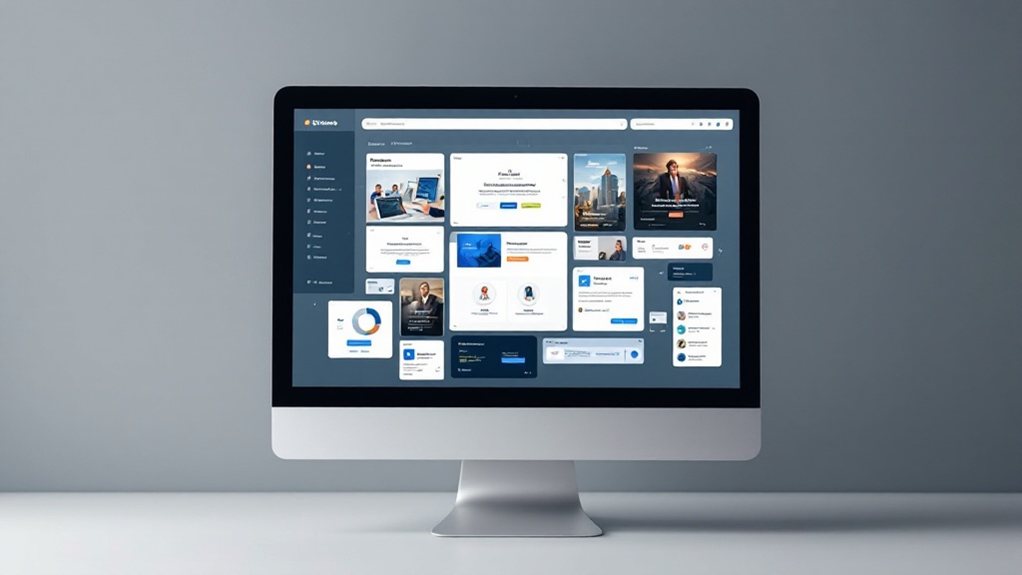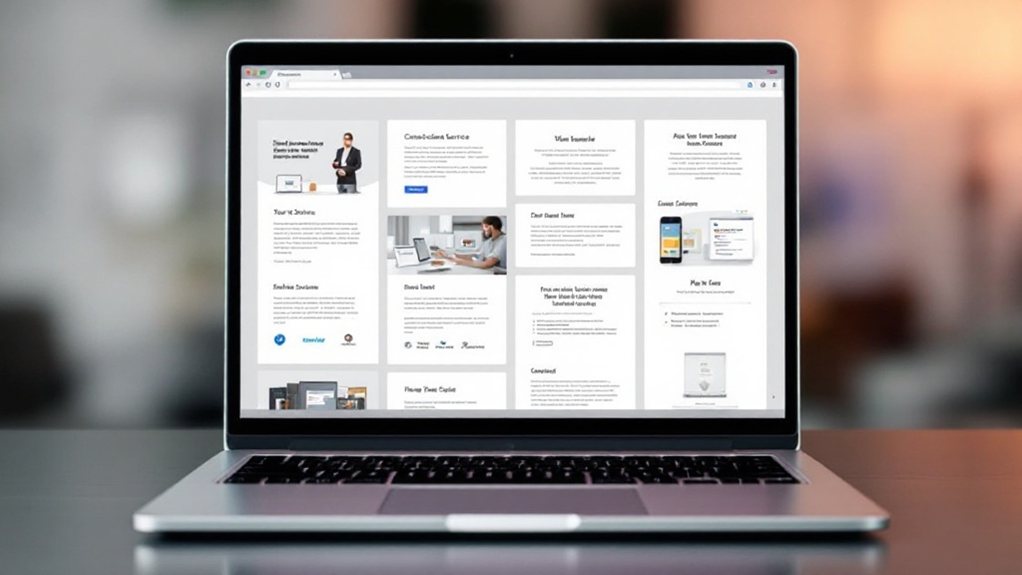To craft unique multi-service pages, diversify your content formats, tailor messaging to specific platforms, and leverage data analysis to optimize your strategies. Utilize adaptive techniques like manual rewording and canonical tags to avoid duplication. Optimize local content with relevant keywords and cultural references, and personalize pages for multi-location businesses. Implement best practices for canonicalization to consolidate link equity and improve rankings. If you'd like to dive deeper into these strategies, keep reading.
Strategies for Crafting Unique Multi-Service Content

When crafting unique multi-service content, you'll want to focus on diversifying your formats and tailoring your messaging to specific platforms. Repurpose your content into various media, like videos, infographics, and podcasts, to appeal to different audience preferences. Ensure your brand messaging remains consistent across channels, but adjust the tone and style to match each platform's audience. Understand the life of each activity to determine how many times content can be reposted. Organize your content using calendars to maintain a steady posting schedule, and leverage analytics to monitor performance and optimize your strategies. By aligning your content with your target audience and efficiently managing your multi-channel efforts, you can create engaging experiences without duplication.
Leveraging Adaptive Techniques to Avoid Duplication

Rewriting content effectively can help you create distinct, localized pages. Leveraging canonical tags ensures search engines prioritize your preferred versions. Consolidating comprehensive pages catered to user needs can boost your SEO while preventing duplication.
Rewording Content Effectively
Crafting unique content that captivates your audience and sidesteps the pitfalls of plagiarism requires a deft touch. Leverage manual rewording techniques, synonyms, and paraphrasing tools to transform your text without losing its meaning. Ensuring the reworded content aligns with your desired tone and flow is crucial. Regularly checking for plagiarism is key to maintaining credibility. Automated solutions can manage large volumes, but manual oversight is crucial to avoid poor quality. Unique content boosts your SEO, reinforces your brand's professionalism, and fosters audience engagement. Utilize localization and language adaptation tools to create fresh, accessible content across platforms. Stay vigilant, and your content will shine brightly, free from the shadow of duplication.
Leveraging Canonical Tags
To effectively manage duplicate content, you can leverage the power of canonical tags. These HTML snippets specify the preferred URL, helping search engines avoid indexing multiple versions. Implement canonical tags in the '
' to consolidate SEO value and improve rankings. Use them for parameterized URLs, pagination, and cross-domain duplicates. Canonical tags, alongside 301 redirects, optimize crawl budgets and prevent content dilution, enhancing the user experience. Platforms like Google Search Console and Moz Pro facilitate identifying and testing canonical tags. Always maintain consistency, ensure correct implementation, and avoid mixed signals. While Google may override your preferences, proper canonicalization remains a crucial strategy for managing multi-service pages without duplicate content.Consolidating Comprehensive Pages
Though content consolidation offers numerous benefits, it requires a careful and adaptive approach to avoid inadvertent duplication. When consolidating pages, focus on:
- Crafting a unique value proposition that accurately represents the merged content
- Creating a detailed content brief to guide the consolidation process
- Regularly updating the consolidated page to maintain relevance and quality
- Leveraging SEO tools to identify and correct any residual duplication
- Refining target keywords to ensure each page serves a distinct search intent
- Prioritizing the removal of low-performing pages that may negatively impact SEO.
Optimizing Local Content for Enhanced User Experience

Optimizing local content is essential for delivering an enhanced user experience. By mirroring the community's voice and culture, your content becomes more discoverable in search results. Leverage tools like Google Keyword Planner to identify local keywords, and incorporate them into your website content. Authenticity is key – use local lingo and cultural references to appeal to your target audience. Regular updates on local events improve content relevance and foster community engagement. Structured data markup clarifies your business information to search engines, aiding in local SEO.
| Local SEO Strategies | |
|---|---|
| Localized Keywords | Hyper-local, Long-tail |
| Content Creation | Community-centric, Multimedia |
| Link Building | Local Backlinks, Influencers |
| Performance Tracking | Analytics, Metrics |
Personalization Tactics for Multi-Location Businesses
Effective personalization strategies are crucial for multi-location businesses to connect with their diverse local audiences. By leveraging tactics like:
- Tailoring content to reflect regional preferences and cultural nuances
- Utilizing geo-targeted ads to reach specific local customers
- Segmenting consumers based on their unique local needs and preferences
- Crafting location-specific messaging that resonates with local expectations
- Hosting events that cater to the interests of the local community
- Optimizing each location's website and online platform to rank for locally targeted search terms.
You can build strong brand affinity and drive meaningful engagement across your various locations. Combining centralized marketing oversight with localized adaptations is key to striking the right balance between consistency and personalization.
Canonicalization Best Practices for Duplicate Content
Ensuring your website's content is free of duplicates is crucial for SEO success. Canonicalization helps solve duplicate content issues by signaling to search engines which webpage is the original or best pick. Start by identifying the original version of your pages, then implement canonical tags to signal search engines your preferred content. Maintaining consistency across URLs is key to avoid mixed signals and maximize the impact of your canonicalization efforts.
Identify Original Content
Identifying original content is crucial in mitigating the risks of duplicate content. Leverage content authenticity tools to ensure your website's integrity:
- Utilize plagiarism detection software to scour the web for matches and identify copied content.
- Analyze writing style and readability to verify the authenticity of your work.
- Employ AI detection tools to ensure your content is human-generated, not machine-produced.
- Examine metadata to validate the origins and provenance of your content.
- Conduct manual reviews and peer evaluations to catch any overlooked duplications or plagiarisms.
- Leveraging a keyword density helper can provide an advantage for content optimization and improve visibility.
Implement Canonical Tags
Implementing canonical tags is crucial for resolving duplicate content issues, ensuring search engines like Google know which version of a page to index and display. Canonical tags tell Google which page version to index, consolidate link equity (ranking strength) to, and display in search results. You can add these tags via HTML, use them in HTTP headers for non-HTML content, or manage them through Content Management Systems (CMS) like WordPress with plugins. Canonical tags must be placed in the '
' section of the HTML document for search engines to recognize them. Avoid pointing these tags to pages that redirect elsewhere, as it can confuse search engines. Properly implemented canonical tags consolidate ranking power, improving search engine rankings. Always use absolute HTTPS URLs, and ensure consistency by allowing self-referential tags when necessary. Regularly audit your canonical tags to avoid indexing confusion and SEO penalties.Maintain Consistency Across URLs
Maintaining consistent URLs across your site is crucial for minimizing duplicate content issues and consolidating search engine authority. Ensure all URLs, including canonical versions, follow a uniform format to avoid confusing search engines. Regularly review and update canonical URLs to reflect changes, and align canonicalization strategies across domains or subdomains. Use canonical tags to specify the preferred HTTPS version, especially during site migrations. Regularly audit your content to identify and address duplicate content, utilizing SEO tools and search engine insights to monitor your progress.
- URL Consistency
- Version Control
- Domain Considerations
- HTTP vs. HTTPS
- Content Duplicates
Mitigating the SEO Impact of Duplicate Content
While duplicate content can significantly impact your website's search engine optimization (SEO) performance, there are practical strategies you can employ to mitigate its adverse effects. Canonicalization, where you specify a preferred version using rel=canonical, is a powerful tool to consolidate link equity. Implementing 301 redirects to direct users and search engines to the correct page is also crucial. Managing URL parameters and ensuring unique content creation are essential steps. Regularly monitoring your website and conducting SEO audits will help you detect and promptly address any duplicate content issues. By following these best practices, you can minimize the SEO challenges posed by duplicate content and improve your online visibility.
Employing Detection and Management Tools
Numerous free and advanced tools are available to help you detect and manage duplicate content on your website. Utilize free tools like Siteliner and SEOpital's free duplicate content checker to quickly identify duplicate content within your site. For more advanced features, consider tools like Copyscape and DeepCrawl, which analyze content against a large database to find similar or identical text across the web. To manage duplicate content, you can:
- Employ canonical link elements to indicate the preferred version of duplicate content to search engines.
- Implement 301 redirects to consolidate duplicate pages and strengthen the canonical version's authority.
- Use the URL Parameters tool in Google Search Console to manage how parameters are treated to avoid duplication.
- Leverage SEO spiders like Screaming Frog to identify and manage duplicate content across your site.
- Utilize the Coverage report in Google Search Console to identify duplicate content warnings.
Tailoring Content for a Multi-Service Audience
When catering to a multi-service audience, you'll need to thoroughly understand their unique needs, preferences, and knowledge levels. Leverage audience research, social media monitoring, and feedback mechanisms to identify pain points and tailor content accordingly. Use clear, simple language for non-technical users, and emphasize benefits over features. Incorporate compelling visuals like infographics to aid comprehension. Adapt content format and style to suit different platforms, optimizing for search engine visibility. Ensure accessibility for visual learners through multimedia, data visualization, and interactive elements. By delivering personalized, relevant content, you'll drive higher engagement, better conversion rates, and stronger long-term relationships with your diverse audience.
Incorporating Local Elements in Multi-Service Pages
To effectively cater to a multi-service audience, you'll need to seamlessly integrate local elements into your content strategy. This includes incorporating service area maps, providing a comprehensive list of covered locations, optimizing page content with location-specific keywords, highlighting your local expertise, and tailoring geographic content to resonate with local search queries. Leverage local landing pages to showcase your service areas, localize product/service information, and utilize clear calls-to-action. Build trust by showcasing local reviews, partnerships, and community involvement. Lastly, implement schema markup and Google Maps integration to further enhance your local visibility and credibility.
- Service Area Maps
- List of Covered Locations
- Location-Based SEO Optimization
- Highlighting Local Expertise
- Geographic Content Tailoring
Fostering Uniqueness With User-Generated Content
Cultivate authentic narratives by incorporating user-generated content. Amplify local voices through community-driven testimonials and reviews. Leverage interactive components like polls and Q&As to foster engagement and uniqueness.
Cultivate Authentic Narratives
As user-generated content (UGC) continues to captivate consumers with its authenticity, you have the opportunity to cultivate genuine narratives that resonate with your audience. By incorporating UGC into your content strategy, you can foster a sense of trust and connection with your brand. Consider:
- Highlighting customer testimonials and reviews to showcase real-world experiences
- Featuring user-created photos and videos that showcase your products or services in action
- Encouraging your community to share their stories and insights about your brand
- Collaborating with influential creators to produce content that feels authentic and relatable
- Responding to user-generated comments and feedback to demonstrate your brand's responsiveness
Amplify Local Voices
Consumers today crave authenticity, and by amplifying local voices through user-generated content (UGC), you can foster a distinctive brand identity that resonates powerfully. Local influencers and community members can create content that builds social proof and customer trust. Furthermore, UGC can enhance your search engine optimization (SEO) through a steady stream of fresh, relevant content. Consider leveraging UGC software to efficiently manage this content across platforms.
| Benefit | Description | Example |
|---|---|---|
| Community Building | Engaging with local customers fosters loyalty and advocacy. | Collaborating with local influencers to encourage content creation. |
| Cost Efficiency | UGC provides a cost-effective alternative to professional content. | Automating content moderation and management. |
| Technical Integration | UGC software assists in sourcing, curating, and moderating content. | Utilizing tools like Movable Ink and Bazaarvoice. |
Leverage Interactive Components
To foster uniqueness and engagement on your multi-service pages, you can leverage a variety of interactive components. Offer product customizers that allow users to personalize offerings, and incorporate customer photos showcasing products in real-life situations to promote authenticity. Present data through interactive infographics, and include social sharing buttons to facilitate user-generated content dissemination. Additionally, implement calculators that help users estimate costs or benefits, and provide 360-degree product views for an immersive experience.
- Product Customizers
- Customer Photos
- Interactive Infographics
- Social Sharing
- Calculators
